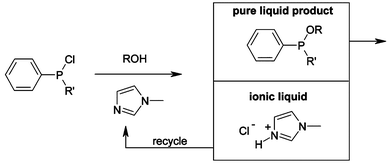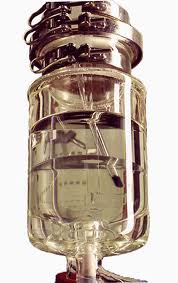Your Current Location is:Home > Application
BASIL TM (Biphasic Acid Scavenging utilising Ionic Liquids) process
Probably, currently, the most successful example of an industrial process using ionic liquid technology is the BASIL TM (Biphasic Acid Scavenging utilising ionic liquids) process. This first commercial publicly announced process was introduced to the BASF site in Ludwigshafen, Germany, in 2002.
The BASILTM process is used for the production of the generic photoinitiator precursor alkoxyphenylphosphines.

In the original process, triethylamine was used to scavenge the acid that was formed in the course of the reaction, but this made the reaction mixture difficult to handle as the waste by-product, triethylammonium chloride formed a dense insoluble paste.

Replacing triethylamine with 1-methylimidazole results in the formation of 1-methylimidazolium chloride, an ionic liquid, which separates out of the reaction mixture as a discrete phase.

This new process uses a much smaller reactor than the initial process; the space-time yield is increased from 8 kg m-3 h-1 to 690,000 kg m-3 h-1, and the yield increased from 50% to 98%. 1-Methylimidazole is recycled, via base decomposition of 1-H-3-methylimidazolium chloride, in a proprietary process. The reaction is now carried out at a multi-ton scale, proving that handling large quantities of ionic liquids is practical. Its success was almost immediately recognised: the process won the ECN Innovation Award in 2004.
1. Natalia V. Plechkova and Kenneth R. Seddon. Chem. Soc. Rev., 2008, 37, 123–150
2. BASF SE, “Method for the Separation of Acids from Chemical Reaction Mixtures by Means of Ionic Fluids,” World Patent WO/2003/062251, Jul. 31, 2003.
3. BASF SE, “Method for Isolating Acids from Chemical Reaction Mixtures by Using 1-Alkylimidazoles,” World Patent WO2005/061416, Jul. 7, 2005.
4. M. Maase, “Aus der Industrie Erstes technisches Verfahren mit ionischen Flüssigkeiten,” Chemie unserer Zeit, 38 (6) 434–435 (2004).
5. M. Freemantle, “BASF’s Smart Ionic Liquid,” Chem. Eng. News 81 (13), 9 (2003).
6. K.R. Seddon, “Ionic liquids: A Taste of the Future,” Nature Mater. 2 (6) 363–365 (2003).
7. K.R. Seddon and R.D. Rogers, “Ionic Liquids: Solvents of the Future,” Science, 302 (5646) 792–793 (2003).
8. J. Chojnowski, M. Cypryk, and W. Fortuniak, “The Extension of the Mechanistic Concept of the Nucleophilic catalysis in the Silicon Chemistry to Some Reactions of the P(III) center: Analogies between Silylation and Phosphorylation,” Heteroatom. Chem. 2 (1), 63–70, 1991.
9. M. Maase, “An Improved Way of Doing It,” presented at the 1st International Congress on Ionic Liquids, Salzburg, Austria, Jun. 20, 2005.
-
Research Institute
-
Application Area
-
Ionic Liquids Used